Thundercloud Electrostatic Field Measurements during the Inflight EXAEDRE Campaign and during Lightning Strike to the Aircraft
Abstract
:1. Introduction
2. AMPERA System
2.1. Electric Field Mill Network on Falcon 20
2.2. Inverse Method
- The field mill on the right window (RW, EFM4) is chosen as the reference because it is in a low curvature part of the aircraft where the geometric approximation is small;
- The ratio between the electric field measured has been computed;
- The coefficients of potential are corrected by using the following expression: where is the potential coefficient associated with the field mill of the right window.
2.3. Inverse Method Error Analysis
3. Atmospheric Electrostatic Field Measurements
3.1. EXAEDRE Campaign
3.2. Electric Field Measurement during EXAEDRE Campaign
3.3. Magnitude of Atmospheric Electrostatic Field Retrieved during the EXAEDRE Campaign
4. Atmospheric Electrostatic Field Measurements
- The effect of altitude is taken into account by dividing the atmospheric electrostatic field value by the relative air density at the flight level. Neglecting the effect of humidity, the relative air density is given by the following expression:where P0 and T0 (P0 = 1013.25 hPa and T0 = 288.15 K) are the international standard atmosphere pressure and temperature at the mean sea level (atmosphere from the ICAO: International Civil Aviation Organization). P and T are the pressure and temperature at the flight level. Derived from the hydrostatic equation and the temperature lapse rate in the troposphere from the ICAO, P and T can be expressed as a function of the altitude z (km) by using:where β is the lapse rate of the international standard atmosphere and is equal to −6.5 K·km−1; R is the specific constant of the dry air ≈287 J·K−1·kg−1; and g is the standard acceleration due to gravity equal to 9.80665 m·s−2. The use of the standard atmosphere parameter (ICAO) is chosen because we perform some comparison with older campaigns where the atmospheric parameters are no longer available.
- The electrical length of the aircraft depends on the direction of the atmospheric electric field in regard to the aircraft orientation. If the electric field component is vertical, the length is the height of the aircraft. If the field is along the fuselage, the electrical length is the aircraft length. For a given atmospheric electrostatic field direction, the electrical length H of the aircraft is computed as follows:

5. Conclusions
Author Contributions
Funding
Institutional Review Board Statement
Informed Consent Statement
Data Availability Statement
Acknowledgments
Conflicts of Interest
References
- Delannoy, A.; Gondot, P. Airborne Measurements of the Charge of Precipitating Particles Related to Radar Reflectivity and Temperature within two Different Convective Clouds. AerospaceLab 2012, 5, 1–8. Available online: https://aerospacelab.onera.fr/al5/airborne-measurements-of-the-charge-of-precipitating-particles-related-to-radar-reflectivity-and-temperature-within-two-diff (accessed on 3 November 2021).
- Laroche, P.; Blanchet, P.; Delannoy, A.; Issac, F. Experimental Studies of Lightning Strikes to Aircraft. AerospaceLab 2012, 5, 1–13. Available online: https://aerospacelab.onera.fr/al5/experimental-studies-of-lightning-strikes-to-aircraft (accessed on 3 November 2021).
- Rust, W.D.; MacGorman, D.R. Techniques for Measuring Electrical Parameters of Thunderstorms. In Instruments and Techniques for Thunderstorm Observation and Analysis; Kessler, E., Ed.; U. Oklahoma Press: Norman, OK, USA, 1988; pp. 91–118. [Google Scholar]
- MacGorman, D.R.; Rust, W.D. The Electrical Nature of Storms; Oxford University Press: New York, NY, USA, 1998. [Google Scholar]
- Kasemir, H.W. The cylindrical field mill. Meteorol. Rundsch. 1972, 25, 33–38. [Google Scholar]
- Jones, J.J. Electric charge acquired by airplanes penetrating thunderstorms. J. Geophys. Res. Atmos. 1990, 95, 16589–16600. [Google Scholar] [CrossRef]
- Chauzy, S.; Médale, J.C.; Prieur, S.; Soula, S. Multilevel measurement of the electric field underneath a thundercloud: 1. A new system and the associated data processing. J. Geophys. Res. Atmos. 1991, 96, 22319–22326. [Google Scholar] [CrossRef]
- Winn, W.P.; Byerley, L.G., III. Electric field growth in thunderclouds. Q. J. R. Meteorol. Soc. 1975, 101, 979–994. [Google Scholar] [CrossRef]
- Marshall, T.C.; Rust, W.D. Electric field soundings through thunderstorms. J. Geophys. Res. Atmos. 1991, 96, 22297–22306. [Google Scholar] [CrossRef]
- Stolzenburg, M.; Rust, W.D.; Smull, B.F.; Marshall, T.C. Electrical structure in thunderstorm convective regions: 1. Mesoscale convective systems. J. Geophys. Res. Atmos. 1998, 103, 14059–14078. [Google Scholar] [CrossRef]
- Gunn, R. Electric Field Intensity Inside of Natural Clouds. J. Appl. Phys. 1948, 19, 481–484. [Google Scholar] [CrossRef]
- Marshall, T.C.; Rison, W.; Rust, W.D.; Stolzenburg, M.; Willett, J.C.; Winn, W.P. Rocket and balloon observations of electric field in two thunderstorms. J. Geophys. Res. Atmos. 1995, 100, 20815–20828. [Google Scholar] [CrossRef]
- Laroche, P. Airborne measurements of electrical atmospheric field produced by convective clouds. Rev. Phys. Appliquée 1986, 21, 809–815. [Google Scholar] [CrossRef]
- Boulay, J.L.; Laroche, P. Aircraft potential variation in flight. Int. Aerosp. Conf. Light. Static Electr. 1982, 1982, 1–19. [Google Scholar]
- Bouchard, A.; Lalande, P.; Laroche, P.; Blanchet, P.; Buguet, M.; Chazottes, A.; Strapp, J.W. Relationship between airborne electrical and total water content measurements in ice clouds. Atmos. Res. 2020, 237, 104836. [Google Scholar] [CrossRef]
- Koshak, W.J.; Bailey, J.; Christian, H.J.; Mach, D.M. Aircraft electric field measurements: Calibration and ambient field retrieval. J. Geophys. Res. 1994, 99, 22781–22792. [Google Scholar] [CrossRef]
- Koshak, W.J. Retrieving Storm Electric Fields from Aircraft Field Mill Data. Part I: Theory. J. Atmos. Ocean. Technol. 2006, 23, 1289–1302. [Google Scholar] [CrossRef]
- Mach, D.M.; Koshak, W.J. General Matrix Inversion Technique for the Calibration of Electric Field Sensor Arrays on Aircraft Platforms. J. Atmos. Ocean. Technol. 2007, 24, 1576–1587. [Google Scholar] [CrossRef] [Green Version]
- Winn, W.P. Aircraft measurement of electric field: Self-calibration. J. Geophys. Res. Atmos. 1993, 98, 7351–7365. [Google Scholar] [CrossRef]
- Bateman, M.G.; Stewart, M.F.; Podgorny, S.J.; Christian, H.J.; Mach, D.M.; Blakeslee, R.J.; Bailey, J.C.; Daskar, D. A Low-Noise, Microprocessor-Controlled, Internally Digitizing Rotating-Vane Electric Field Mill for Airborne Platforms. J. Atmos. Ocean. Technol. 2007, 24, 1245–1255. [Google Scholar] [CrossRef] [Green Version]
- Mach, D.M. Technique for Reducing the Effects of Nonlinear Terms on Electric Field Measurements of Electric Field Sensor Arrays on Aircraft Platforms. J. Atmos. Ocean. Technol. 2015, 32, 993–1003. [Google Scholar] [CrossRef]
- Mazur, V.; Ruhnke, L.H.; Rudolph, T. Effect of E-field mill location on accuracy of electric field measurements with instrumented airplane. J. Geophys. Res. Atmos. 1987, 92, 12013–12019. [Google Scholar] [CrossRef]
- Mach, D.M.; Blakeslee, R.J.; Bateman, M.G.; Bailey, J.C. Electric fields, conductivity, and estimated currents from aircraft overflights of electrified clouds. J. Geophys. Res. Atmos. 2009, 114, 1–15. [Google Scholar] [CrossRef]
- Baumgardner, D.; Brenguier, J.L.; Bucholtz, A.; Coe, H.; DeMott, P.; Garrett, T.J.; Gayet, J.F.; Hermann, M.; Heymsfield, A.; Korolev, A.; et al. Airborne instruments to measure atmospheric aerosol particles, clouds and radiation: A cook’s tour of mature and emerging technology. Atmos. Res. 2011, 102, 10–29. [Google Scholar] [CrossRef] [Green Version]
- Lawson, R.P.; O’Connor, D.; Zmarzly, P.; Weaver, K.; Baker, B.; Mo, Q.; Jonsson, H. The 2D-S (Stereo) Probe: Design and Preliminary Tests of a New Airborne, High-Speed, High-Resolution Particle Imaging Probe. J. Atmos. Ocean. Technol. 2006, 23, 1462–1477. [Google Scholar] [CrossRef] [Green Version]
- Lawson, R.P.; Baker, B.; Pilson, B.; Mo, Q. In Situ Observations of the Microphysical Properties of Wave, Cirrus, and Anvil Clouds. Part II: Cirrus Clouds. J. Atmos. Sci. 2006, 63, 3186–3203. [Google Scholar] [CrossRef] [Green Version]
- Protat, A.; Bouniol, D.; Delanoë, J.; O’Connor, E.; May, P.T.; Plana-Fattori, A.; Hasson, A.; Görsdorf, U.; Heymsfield, A.J. Assessment of Cloudsat Reflectivity Measurements and Ice Cloud Properties Using Ground-Based and Airborne Cloud Radar Observations. J. Atmos. Ocean. Technol. 2009, 26, 1717–1741. [Google Scholar] [CrossRef] [Green Version]
- Delanoë, J.; Protat, A.; Jourdan, O.; Pelon, J.; Papazzoni, M.; Dupuy, R.; Gayet, J.F.; Jouan, C. Comparison of Airborne In Situ, Airborne Radar–Lidar, and Spaceborne Radar–Lidar Retrievals of Polar Ice Cloud Properties Sampled during the POLARCAT Campaign. J. Atmos. Ocean. Technol. 2013, 30, 57–73. [Google Scholar] [CrossRef]
- Dye, J.E.; Bansemer, A. Electrification in Mesoscale Updrafts of Deep Stratiform and Anvil Clouds in Florida. J. Geophys. Res. Atmos. 2019, 124, 1021–1049. [Google Scholar] [CrossRef]
- Marshall, T.C.; Stolzenburg, M.; Maggio, C.R.; Coleman, L.M.; Krehbiel, P.R.; Hamlin, T.; Thomas, R.J.; Rison, W. Observed electric fields associated with lightning initiation. Geophys. Res. Lett. 2005, 32, 1–5. [Google Scholar] [CrossRef] [Green Version]
- Stolzenburg, M.; Marshall, T.C. Charge Structure and Dynamics in Thunderstorms. Space Sci. Rev. 2008, 137, 355–372. [Google Scholar] [CrossRef]
- Lalande, P.; Bondiou-Clergerie, A.; Bacchiega, G.; Gallimberti, I. Observations and modeling of lightning leaders. Comptes Rendus Phys. 2002, 3, 1375–1392. [Google Scholar] [CrossRef]
- Willett, J.C.; Davis, D.A.; Laroche, P. An experimental study of positive leaders initiating rocket-triggered lightning. Atmos. Res. 1999, 51, 189–219. [Google Scholar] [CrossRef]
- Coquillat, S.; Defer, E.; De Guibert, P.; Lambert, D.; Pinty, J.P.; Pont, V.; Prieur, S.; Thomas, R.J.; Krehbiel, P.R.; Rison, W. SAETTA: High-resolution 3-D mapping of the total lightning activity in the Mediterranean Basin over Corsica, with a focus on a mesoscale convective system event. Atmos. Meas. Tech. 2019, 12, 5765–5790. [Google Scholar] [CrossRef] [Green Version]
- Ribaud, J.F.; Bousquet, O.; Coquillat, S. Relationships between total lightning activity, microphysics and kinematics during the 24 September 2012 HyMeX bow-echo system. Q. J. R. Meteorol. Soc. 2016, 142, 298–309. [Google Scholar] [CrossRef] [Green Version]
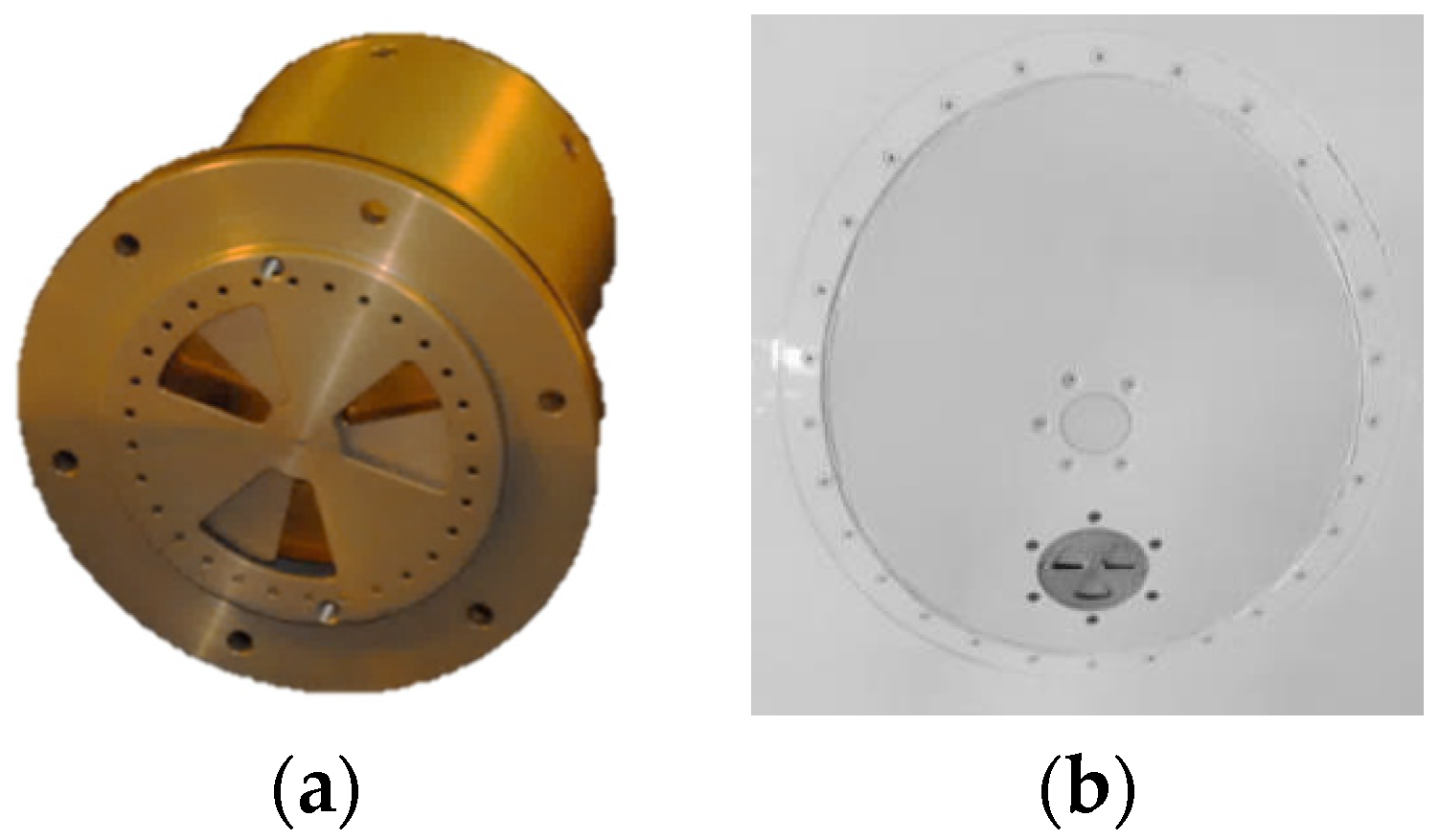
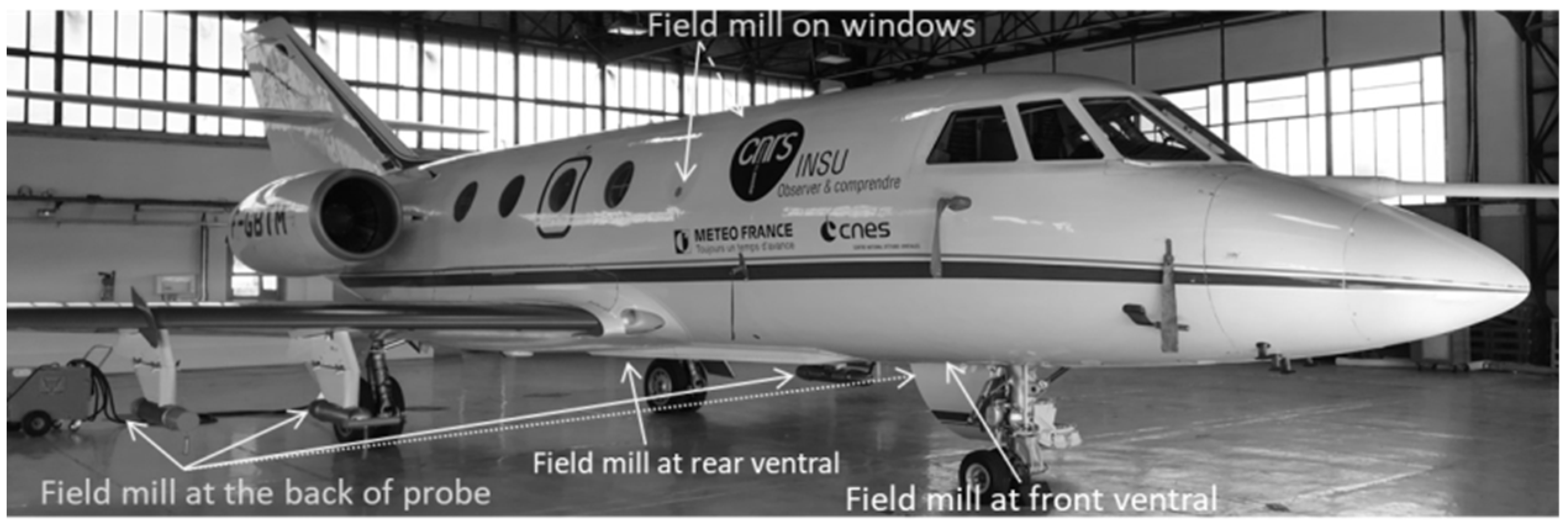
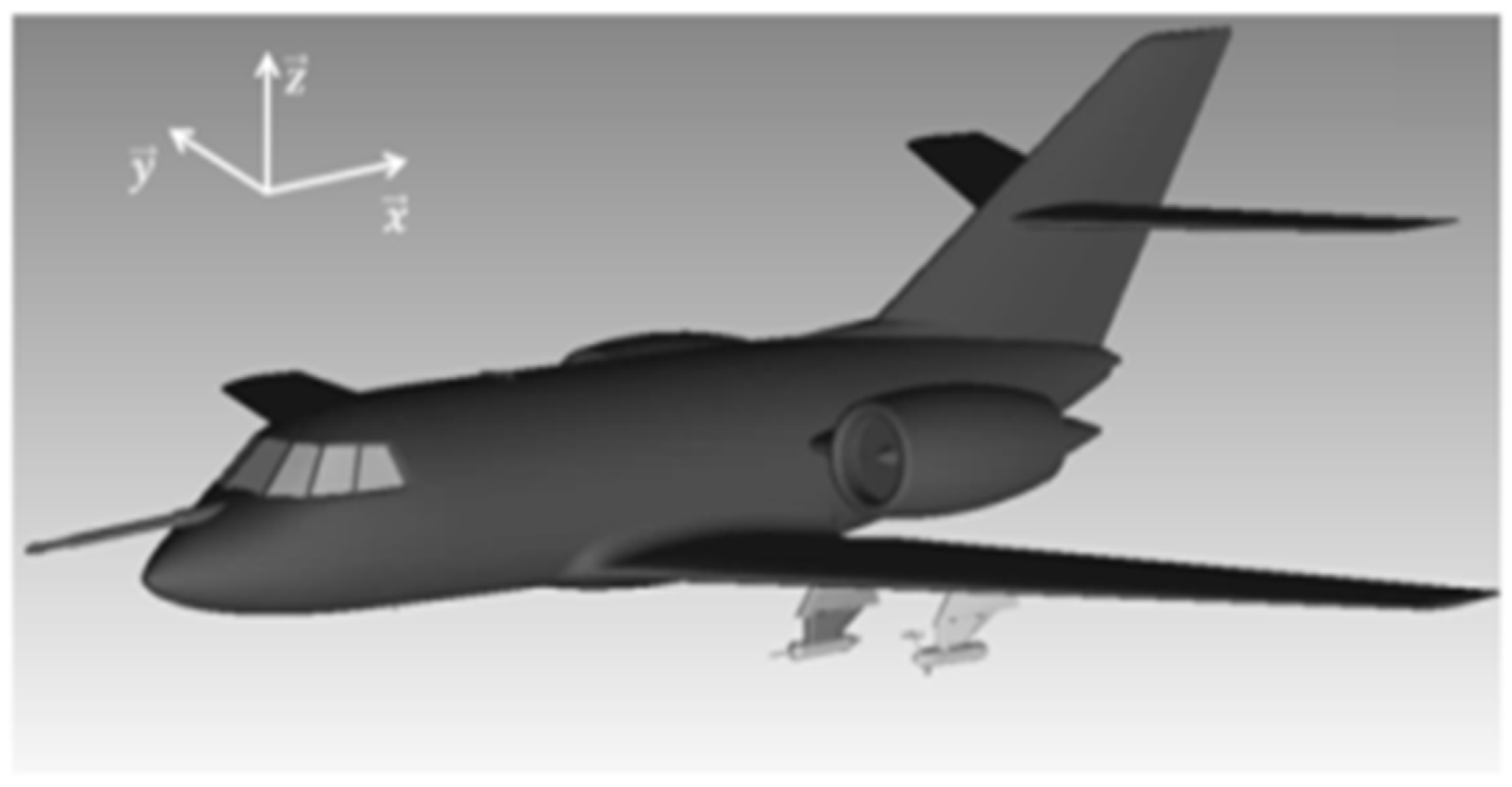
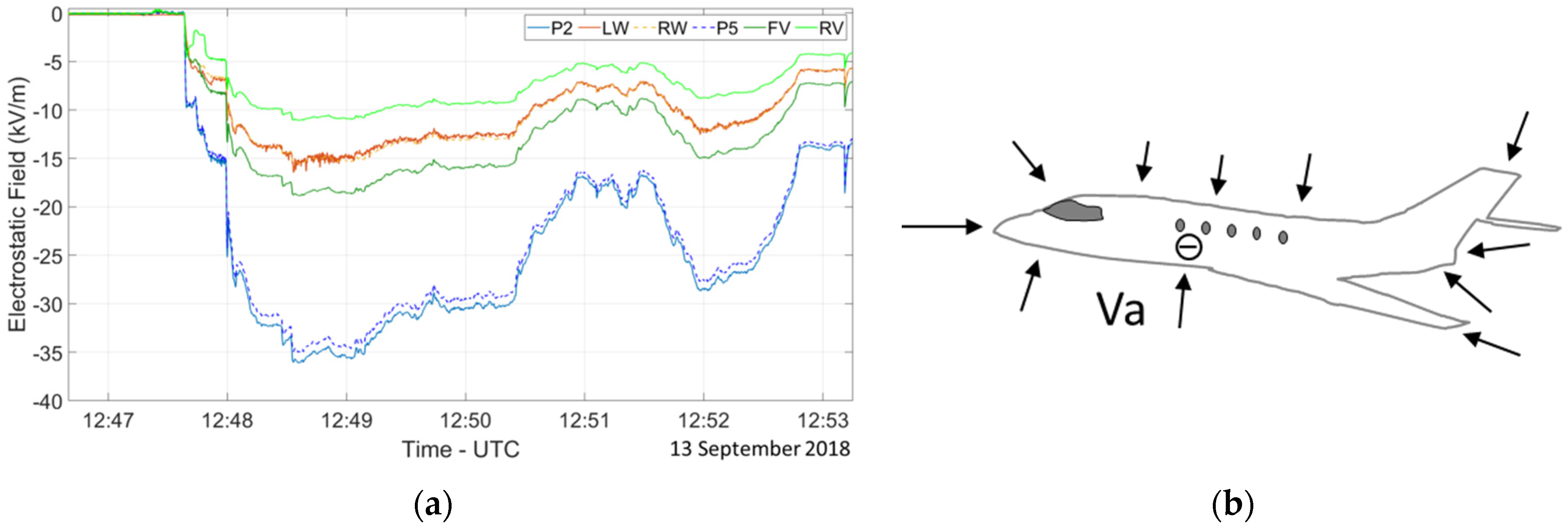
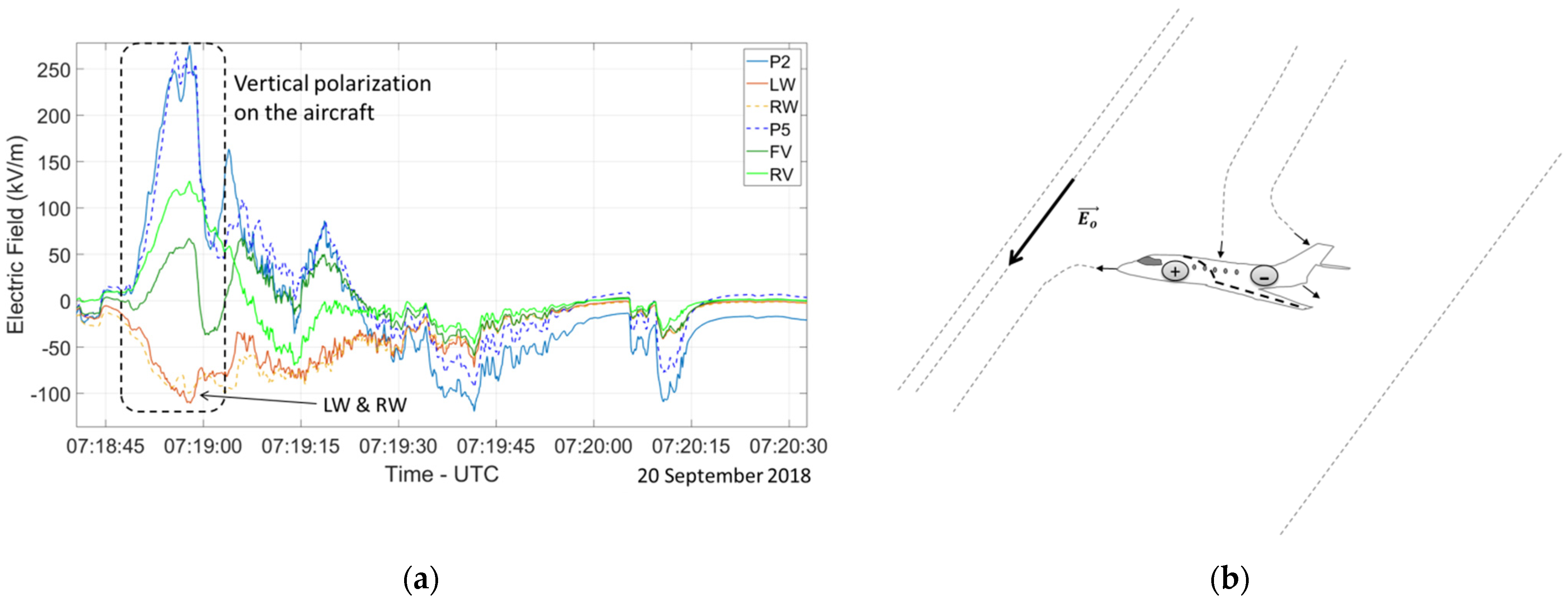

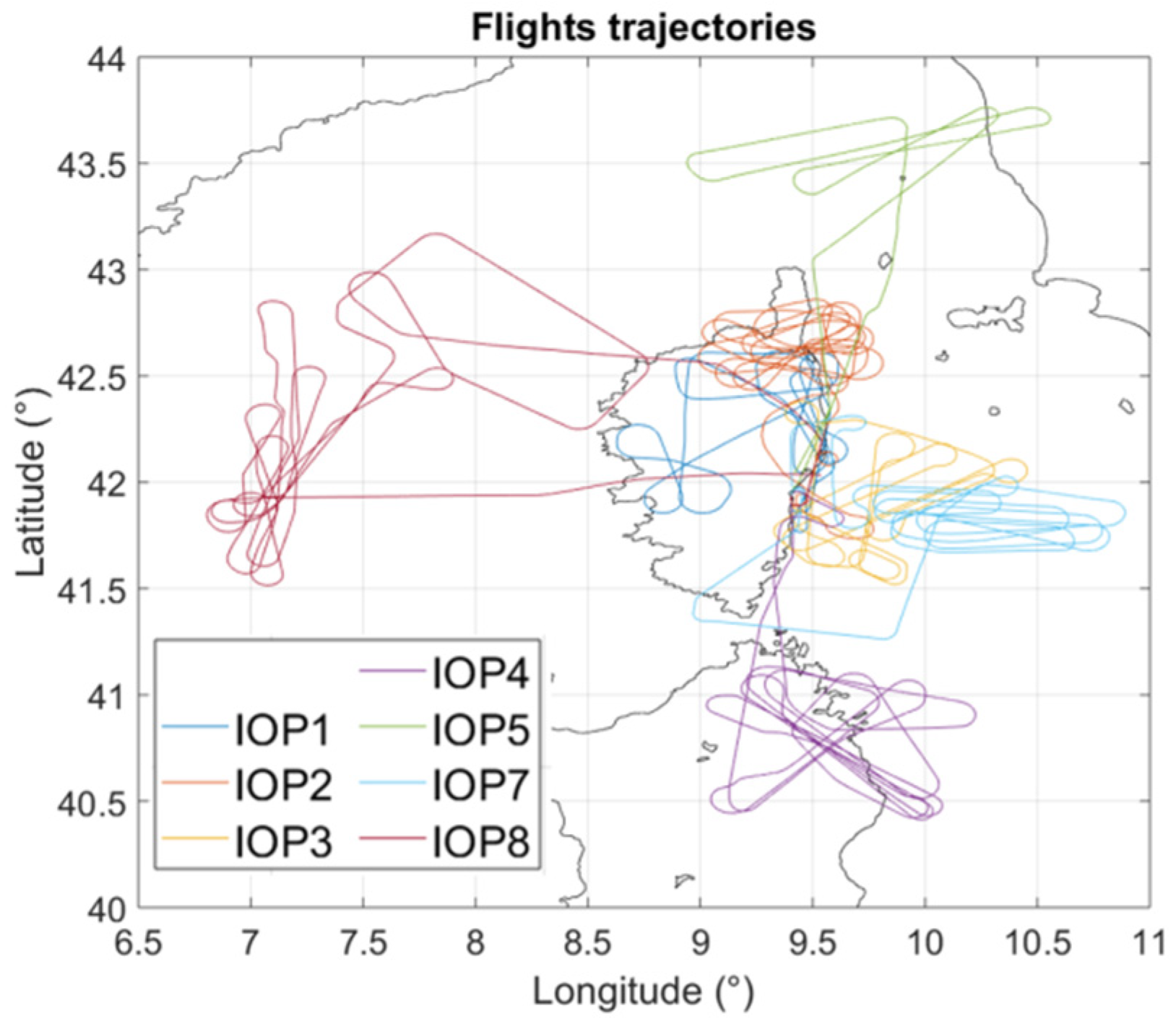
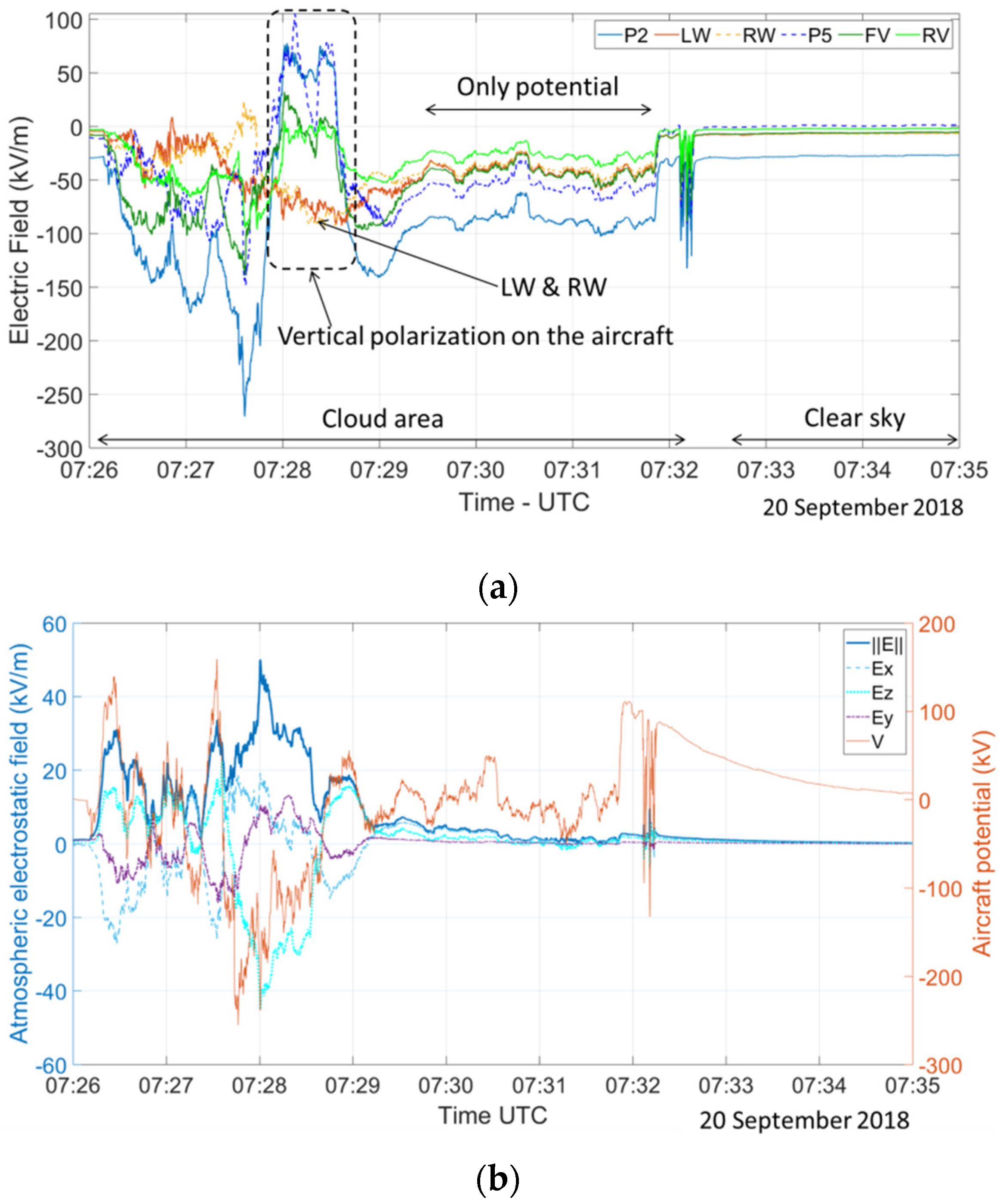
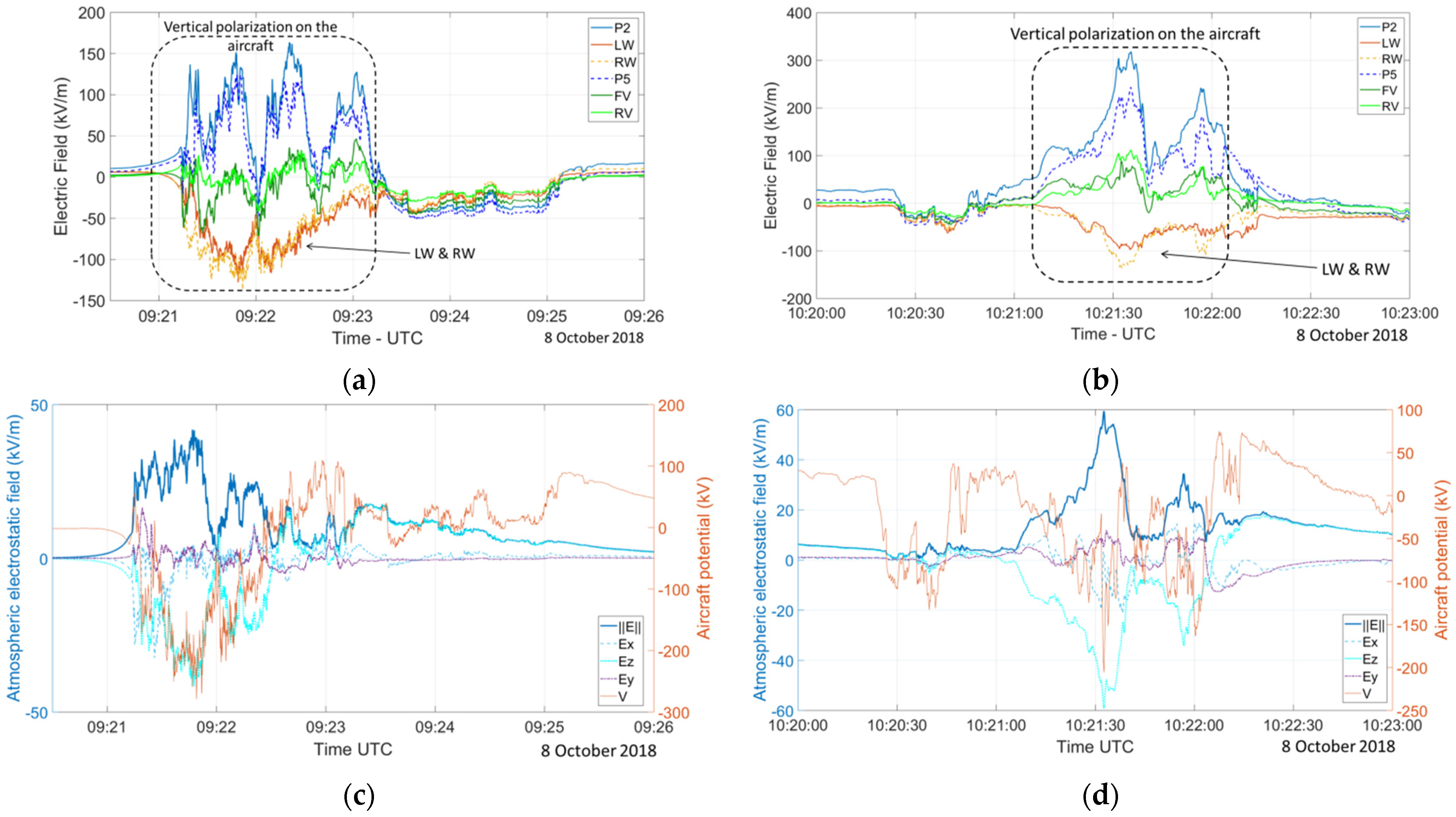
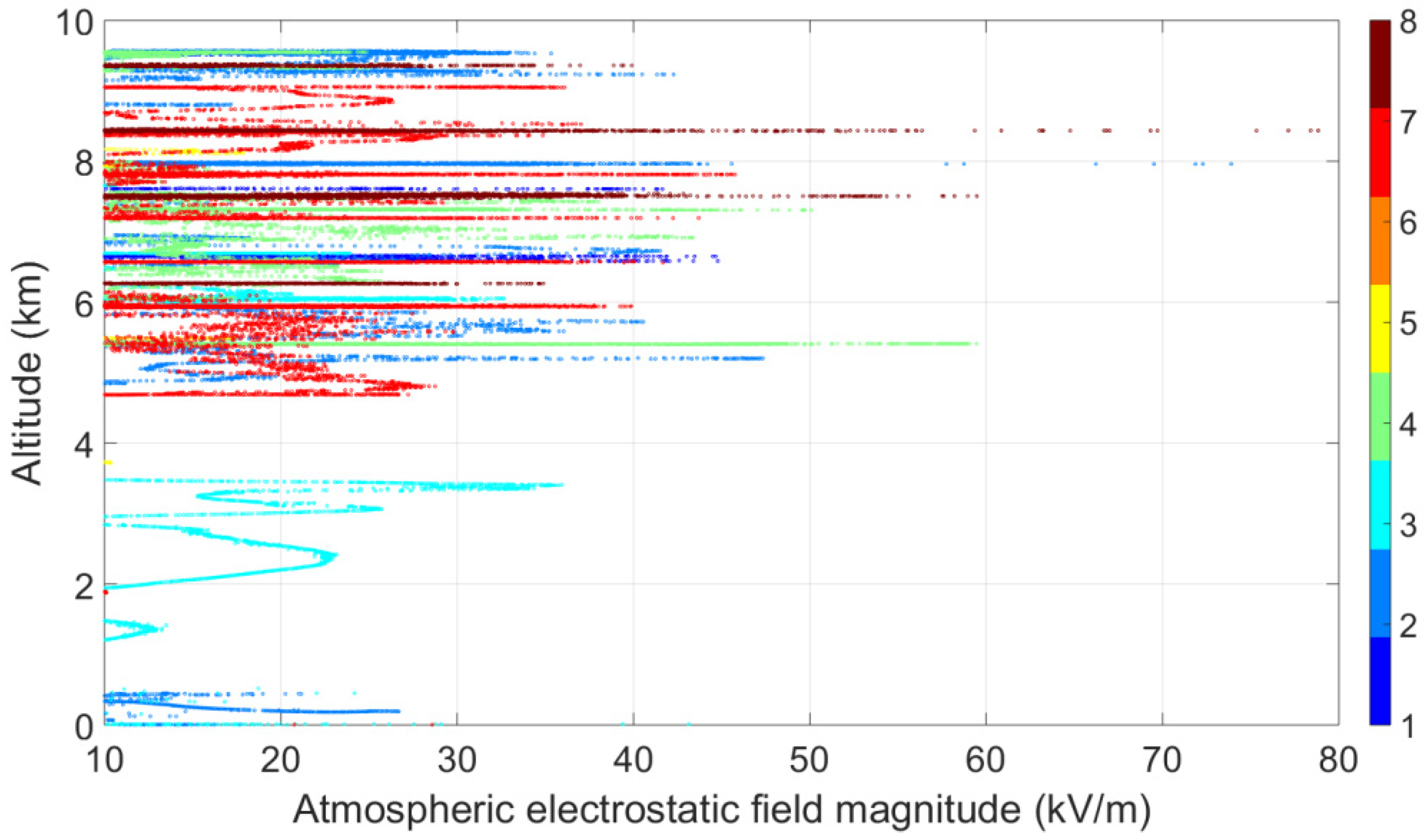


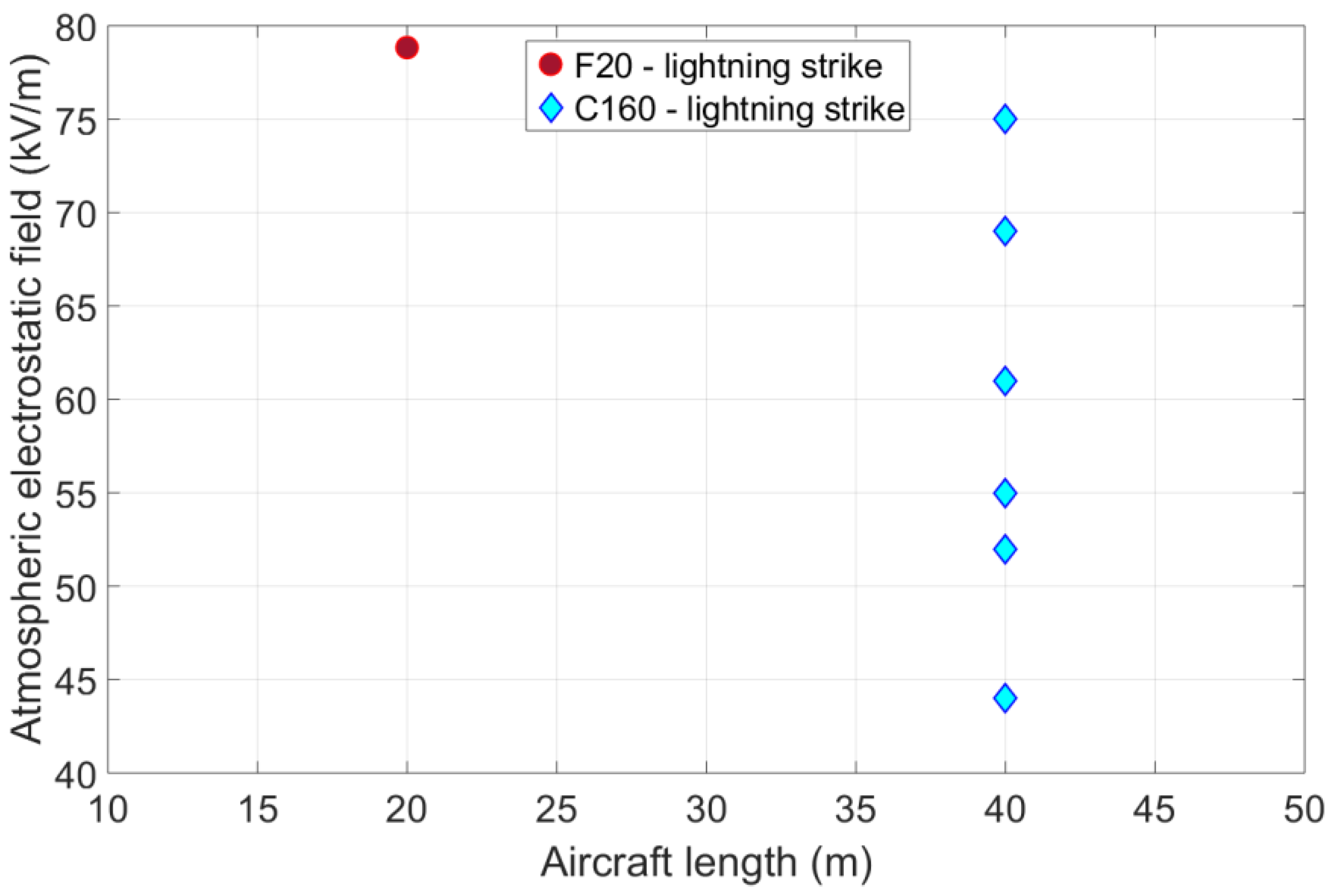
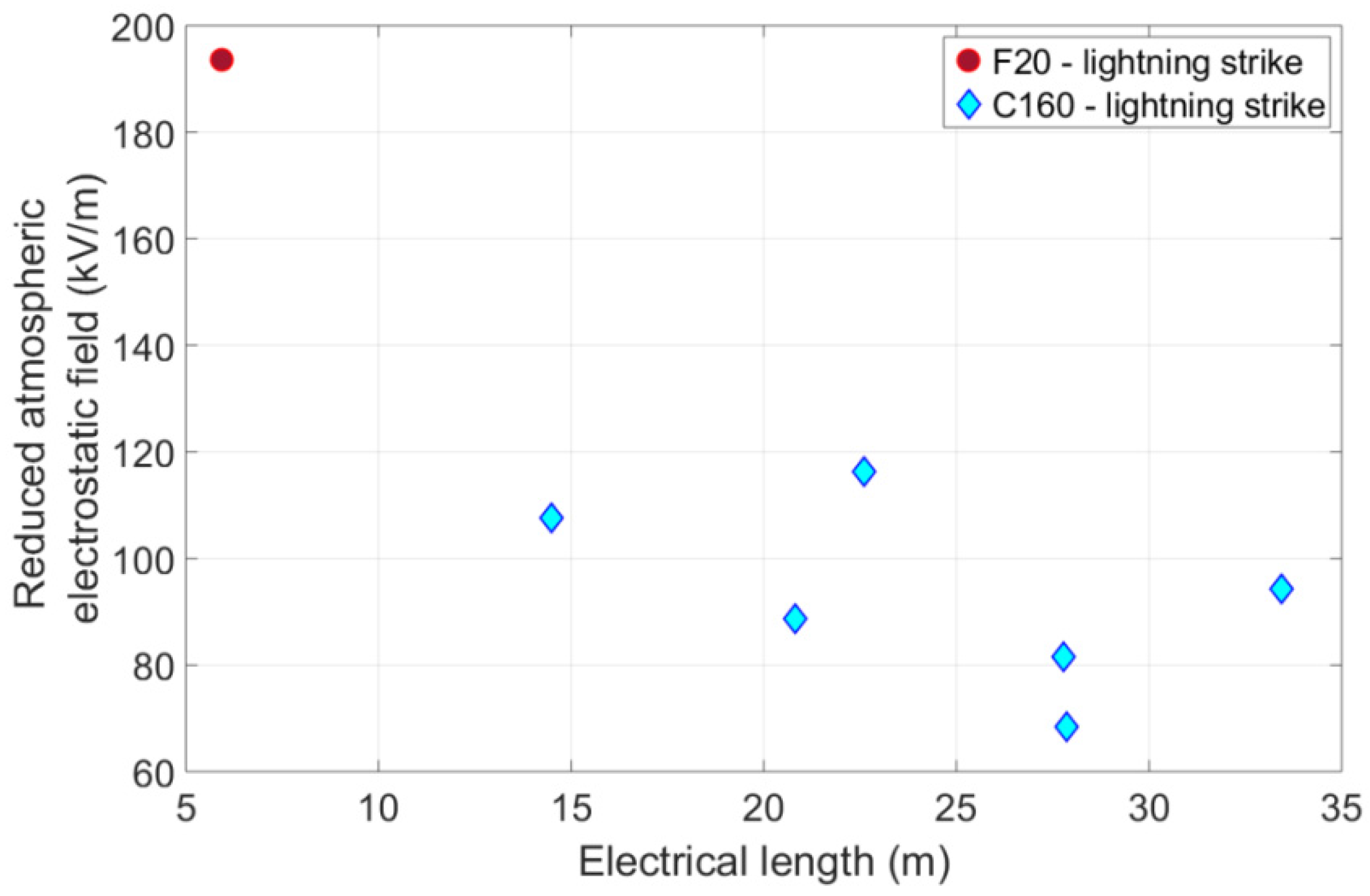

| Physical | Mass | 0.870 kg |
| Power | 28 V (DC); 25 W max | |
| Size | 120 mm × 115 mm | |
| Dynamic Range | +/−5 V/m to +/−1 MV/m | |
| Threshold of Detection | Below 5 kV/m | 5 V/m |
| Above 5 kV/m | 20 V/m | |
| Sampling Rate | 10 Hz |
| Name | Number | Aircraft Location |
|---|---|---|
| P1 | EFM1 | Back of the external left pod |
| P2 | EFM2 | Back of the internal left pod |
| LW | EFM3 | Left window (1st left window) |
| RW | EFM4 | Right window (1st right window) |
| P5 | EFM5 | Back of the internal right pod |
| P6 | EFM6 | Back of the external right pod |
| FV | EFM7 | Front ventral |
| RV | EFM8 | Rear ventral |
| Name | Number | Eox | Eoy | Eoz | Va |
|---|---|---|---|---|---|
| P2 | EFM2 | 1.23 | 3.45 | −5.26 | 0.55 |
| LW | EFM3 | 2.00 | 1.41 | 0.70 | 0.24 |
| RW | EFM4 | 2.00 | −1.14 | 0.70 | 0.24 |
| P5 | EFM5 | 1.23 | −3.45 | −5.26 | 0.55 |
| FV | EFM7 | 2.79 | 0 | −2.06 | 0.29 |
| RV | EFM8 | 0.1 | 0 | −1.65 | 0.19 |
| N° | Ex (kV/m) | Ey (kV/m) | Ez (kV/m) | E (kV/m) | V (kV) | Alt (km) |
|---|---|---|---|---|---|---|
| 1 | 33 | −19 | −40 | 55 | −1950 | 4.6 |
| 2 | 45 | −7 | −26 | 52 | −840 | 4.2 |
| 3 | 31 | 15 | −60 | 69 | 85 | 4.2 |
| 4 | −30 | 14 | −29 | 44 | −157 | 4.2 |
| 5 | 58 | −5 | 17 | 61 | −1335 | 4.2 |
| 6 | 37 | −36 | −54 | 75 | −1890 | 4.2 |
| N° | Ex (kV/m) | Ey (kV/m) | Ez (kV/m) | E (kV/m) | V (kV) | Alt (km) |
|---|---|---|---|---|---|---|
| 1 | −4 | −23 | −75 | 79 | −159 | 8.4 |
Publisher’s Note: MDPI stays neutral with regard to jurisdictional claims in published maps and institutional affiliations. |
© 2021 by the authors. Licensee MDPI, Basel, Switzerland. This article is an open access article distributed under the terms and conditions of the Creative Commons Attribution (CC BY) license (https://creativecommons.org/licenses/by/4.0/).
Share and Cite
Buguet, M.; Lalande, P.; Laroche, P.; Blanchet, P.; Bouchard, A.; Chazottes, A. Thundercloud Electrostatic Field Measurements during the Inflight EXAEDRE Campaign and during Lightning Strike to the Aircraft. Atmosphere 2021, 12, 1645. https://doi.org/10.3390/atmos12121645
Buguet M, Lalande P, Laroche P, Blanchet P, Bouchard A, Chazottes A. Thundercloud Electrostatic Field Measurements during the Inflight EXAEDRE Campaign and during Lightning Strike to the Aircraft. Atmosphere. 2021; 12(12):1645. https://doi.org/10.3390/atmos12121645
Chicago/Turabian StyleBuguet, Magalie, Philippe Lalande, Pierre Laroche, Patrice Blanchet, Aurélie Bouchard, and Arnaud Chazottes. 2021. "Thundercloud Electrostatic Field Measurements during the Inflight EXAEDRE Campaign and during Lightning Strike to the Aircraft" Atmosphere 12, no. 12: 1645. https://doi.org/10.3390/atmos12121645
APA StyleBuguet, M., Lalande, P., Laroche, P., Blanchet, P., Bouchard, A., & Chazottes, A. (2021). Thundercloud Electrostatic Field Measurements during the Inflight EXAEDRE Campaign and during Lightning Strike to the Aircraft. Atmosphere, 12(12), 1645. https://doi.org/10.3390/atmos12121645






